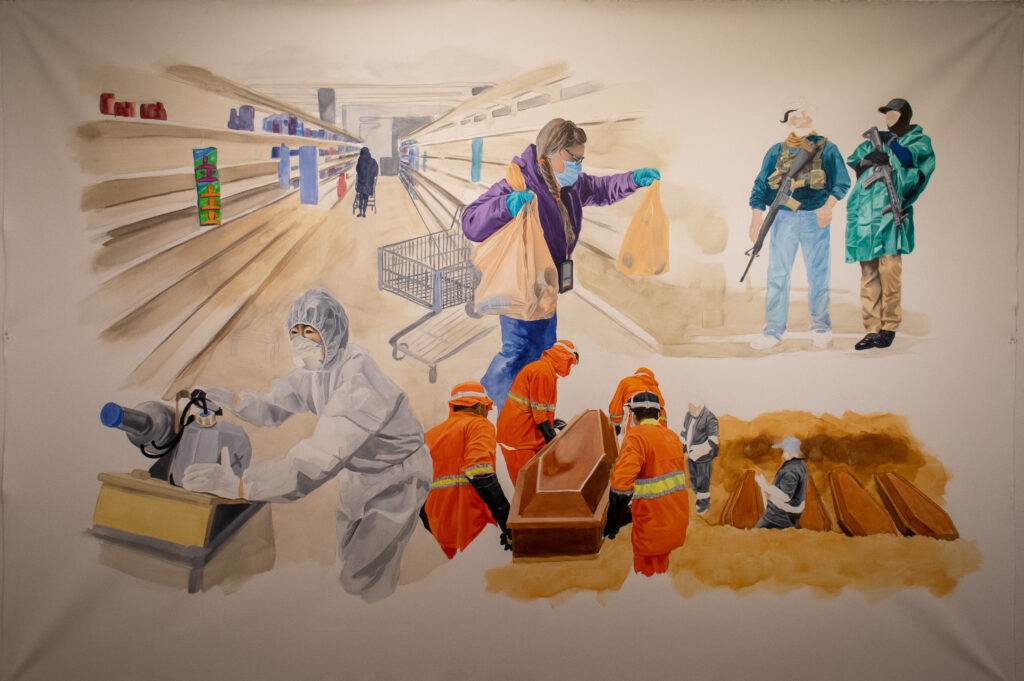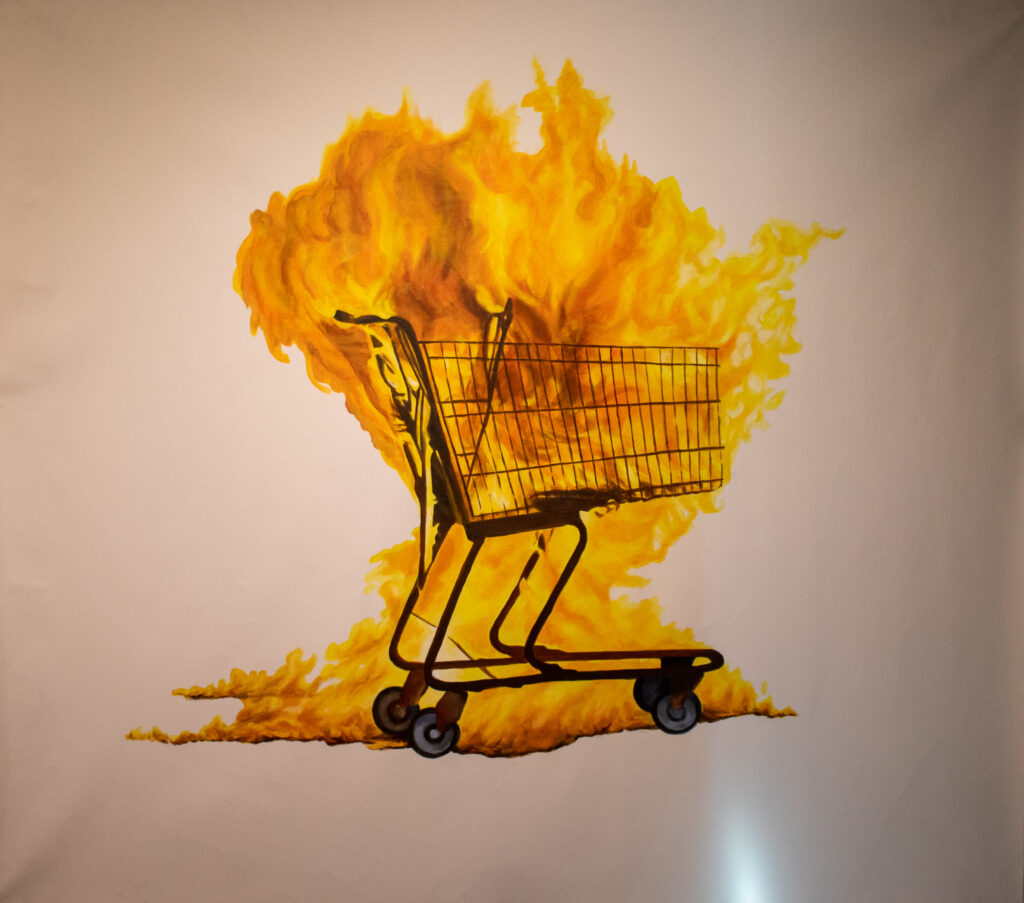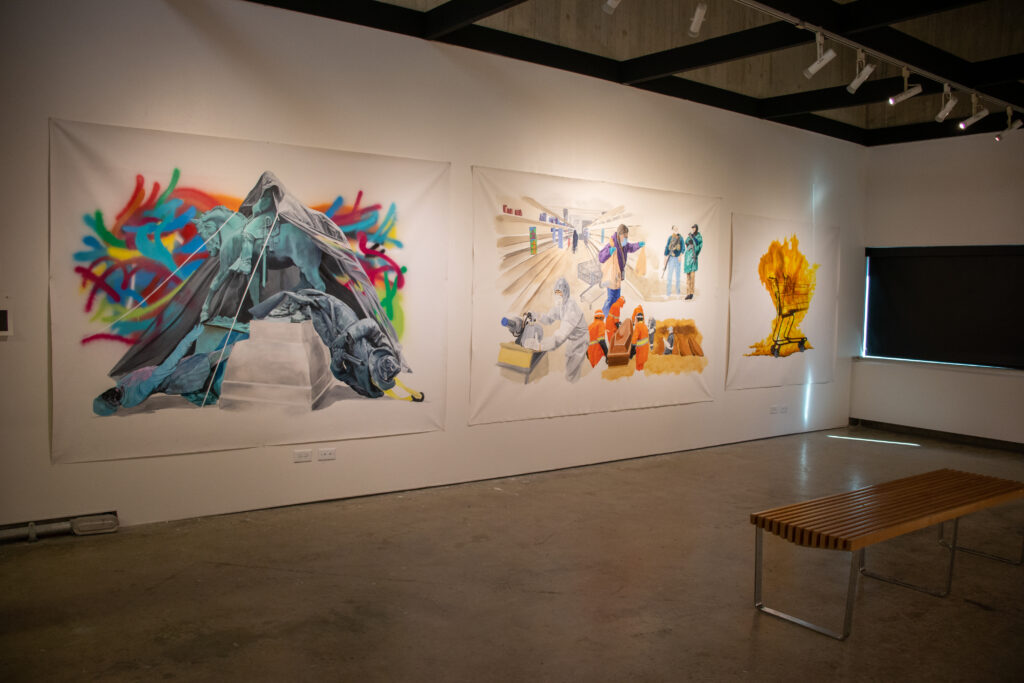NERON SIMPSON
Special to The Leader

How does one respond to a crisis? With the onslaught of the COVID-19 pandemic, increasing racial tensions and scientific skepticism, controversy has continued to evolve in recent years. Patrick Foran, a SUNY Fredonia visual arts and new media professor, responded to some of these developments in a thought-provoking series of paintings.
“Exploded View” offers glimpses into various events and controversies that have been highlighted over the years within the media. In his acrylic painting “The Hollow Men” (2020), Foran depicts the defamation and tearing-down of confederate statues. Confederate monuments were built during the Jim Crow era to honor soldiers of the confederacy. However, they have been criticized for upholding white supremacist ideologies and ziegesit as well as contributing to racial violence and segregation, specifically in regards to African-American communities.
One part of the painting that stands out is the covering of the faces. One soldier is wearing a large hat, another is covered in black spray paint and the last one is covered by a drape.
One of the other poignant pieces in the exhibition is his acrylic painting “Community Spread (2020),” which depicts people salvaging the last groceries available in a store with empty shelves. The bottom right corner shows a group of people wearing hazmat suits, while placing caskets in a gravesite. This was one of the unfortunate realities of the pandemic for many people, disproportionately affecting those without a next-of-kin and families who were unable to afford a proper burial.
The exhibit also features standalone portraits of engaging subjects, such as a shopping cart engulfed in flames, an overturned car and a pair of medical professionals staring aimlessly in opposite directions.

In the exhibit, Foran challenged the notion of crisis. I think, how far apart can people go before being forced to come together for a common goal? What are the limits of ignorance? Foran answered a few questions about his work as well as his upbringing in the art world.
1. We know you were inspired by events in the news as well as social media broadcasts for the subjects in your paintings. Was there a specific event or turning point that made you decide you wanted to pick up a brush and say something about it?
“Even before the various upheavals of the past two years, my work was concerned with the way individuals experience crises on a collective level, and how we respond to them from a distance. This often led me to consider how events are relayed and consumed through social media, broadcast news and other networks of information transmission. In 2020, there was a cascade of events, seemingly one after another, unfolding and overlapping in real time. [Each event] felt directly related to the ideas that were already defining my work.
From the global pandemic, to protests and riots, demands for social justice, the proliferation of conspiracy theories, political polarization and distrust of government, crises were emerging at the speed of a virus — spreading and replicating through the social body of the country and the world. The work I’ve been doing during this period is more or less an attempt at responding to these events — trying to find a way to process the many simultaneous streams of information, emotion, conflict and concern that emerge on a daily cycle.”
2. What motivated you to become an artist?
“I don’t know if I made a conscious decision to ‘become an artist’ at any specific point. I think of it more as the logical destination at the end of a pathway I’ve always been moving along. I’ve always had a strong desire to take the things that are in my head and make them exist in the world. Creating art, which I generally think of as a way of opening a space for thought or discussion, made sense as a way to engage with the things that interest me most: images, visual communication, social discourse, the exchange of ideas. All of my passions — art, teaching, writing — are ways of exploring those fundamental ideas, the things that have always been driving me.”
3. How has your teaching style evolved with the occurrence of the COVID-19 pandemic?
“Teaching in the era of COVID-19 has been a huge challenge for everyone. At various points, I’ve tried to adapt my teaching to every mode available: asynchronous remote with pre-recorded lectures, remote through Zoom with ‘live’ meetings, distanced face to face, outdoors, etc. I’ve tried to be flexible, and I think it’s helped me hone in on the most fundamental material in each course. When you’re limited in terms of physical space and proximity, you become forced to be more selective and direct. I really enjoyed running my Foundations in Drawing class outdoors in the fall, but of course in Fredonia that modality had a limited time frame. Once the freezing rain started in October, we had to cut our losses and move indoors. But, I would teach on the quad or in the woods every day if I could.”

4. What is some advice you would give to an aspiring artist?
“Draw, paint, sculpt, print, doodle, graffiti or stipple something every day. Try working in a medium that you’re bad at. Make assemblages out of sticks and pine cones in the woods that no one else will ever see. Draw your cat while it’s sleeping, and then keep drawing after it stretches and walks away. Invent your own origami design. Keep a sketchbook, and don’t be too precious about it. Put lots of things in it, and expect those things to mostly be failures or ideas that never go anywhere. Write down all of your dreams, especially the fragments. Record your thoughts because they never stay in one place for very long and no one else will do it for you. The important thing is to keep your mind in motion; eventually, it will find a good place to land.”
“Exploded View” was on display from Oct.31 through Nov. 10 in the Emmitt Christian gallery in the Rockefeller Arts Center. You can still view the full exhibition on Foran’s website: www.patrickforan.info.
